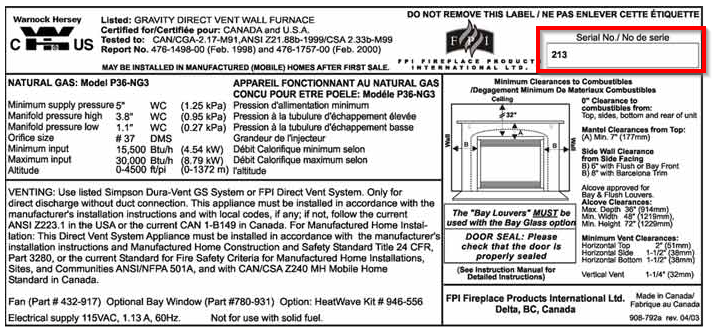How to Tell if you have an Insert or Fireplace
The best way to tell if you have an insert or fireplace is to inspect the rate plate or labeling on the underside of the unit. Rate plates will typically be in the control panel underneath your gas unit or in the air channel on your wood unit. On some older models, your rate plate could be on the side or unreadable, and if that is the case, you will likely need the following steps to be able to determine whether you have an insert or a fireplace.
What is a Rate Plate?
A rate plate is a mandatory label that is included in every wood or gas appliance, and it includes all relevant manufacturing, testing, certification, and compliance information. It looks like the image below and will include your Serial number & fireplace make/model.

Differentiating Gas Fireplaces & Gas Inserts
Installation
Installed into a masonry structure or opening – if your gas unit is installed in a stone/masonry fireplace that looks as though it was originally there, and the fireplace was added afterward, it is likely an insert.
Installed into a wall or framed structure - If the gas fireplace is built into a wall and there is no evidence of a chimney or preexisting fireplace structure, this is likely a gas fireplace.
Inspect the edges of your unit – if it has a surround or backing plate covering the edges, try and remove it (if you can) or look behind it. If there are gaps and the existence of a stone/masonry encasing it is an insert. Inserts are retrofit appliances used to update old fireplaces and are typically used during a renovation to transform a fireplace. If there are no gaps and the fireplace is framed using wood or steel stud, it is a fireplace.
.aspx)
Venting
Is there a Chimney? If there is an existing brick chimney, then you likely have a gas insert. Gas inserts use the chimney to run venting to the top, and there will be a gas fireplace cap on the top of the chimney.
Is there a vent/termination on the side of your house? If there is a vent on the side of your house, it is a gas fireplace. Gas fireplaces use two technologies (direct vent or natural venting – see venting explained) both venting technologies go directly outside the home and do not typically use chimneys. The venting cap on the exterior of your home will look something like image 1 below.
.aspx) Image 1: Examples of Direct Vent Horizontal Termination Caps
Image 1: Examples of Direct Vent Horizontal Termination Caps
Differentiating Wood Fireplaces & Wood Inserts
Installation
Differentiating between a wood fireplace and wood inserts can be a little more difficult as many people build their wood fireplaces to resemble chimneys using stone and bricks to give it that more rustic traditional look. However, the same theory applies to wood units as gas – if it is built into a preexisting fireplace and added afterward, it is likely an insert, if it’s built into a wall or structure that is then covered in stone/brick/other material to resemble a full traditional hearth it is likely a fireplace.
Inspect the edges of the fireplace – if the fireplace has a surround or backing plate covering the edges, try and remove it (if you can) or look behind it. If there are gaps and the existence of a stone/masonry encasing it is an insert. If there are no gaps and the fireplace is built into the wall, it is a fireplace.
Venting
Wood venting can also be more complicated to tell the difference between than a gas unit. Wood units both need to be vented vertically, with inserts being vented out of a chimney or existing vent structure and fireplaces using rigid stove piping. If you have a chimney with a wood cap on it, you likely have a wood insert. If you have a pipe protruding from your roof with a wood cap on it, you likely have a fireplace (see picture 3 below).
.aspx) Image 2: Sample Wood Fireplace Pipe & Cap
Image 2: Sample Wood Fireplace Pipe & Cap
Types of Vent Caps
There are many types of venting caps, and they vary based on fuel type (wood vs. gas), elevation, location (valley vs. mountaintop vs. city center), and more. Here are two more common caps found in windy areas for Regency gas fireplaces and inserts.
.aspx) Image 3: Examples of Gas Caps for Windy Areas
Image 3: Examples of Gas Caps for Windy Areas
Disclaimer: This is simply meant as a guide to help you differentiate between two similar product types. Each case is unique, and depending on the make/model/installation of your unit, any of the above information could vary. It is always best to consult a professional fireplace dealer whenever inspecting your fireplace or venting.
You May Also Like…